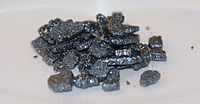
Photo from wikipedia
Purpose This study aimed to investigate the prognostic value of systemic immune-inflammation index (SII) in patients with extrahepatic cholangiocarcinoma (EHCC) treated by percutaneous transhepatic biliary stenting (PTBS) combined with 125I… Click to show full abstract
Purpose This study aimed to investigate the prognostic value of systemic immune-inflammation index (SII) in patients with extrahepatic cholangiocarcinoma (EHCC) treated by percutaneous transhepatic biliary stenting (PTBS) combined with 125I seed intracavitary irradiation and further develop a predictive model related to SII. Methods A total of 145 patients with EHCC who received PTBS combined with 125I seed implantation were retrospectively analyzed. The optimal cut-off value of SII was identified by receiver operating characteristic (ROC) curve analysis. Kaplan–Meier curves and Cox regression were applied to estimate the prognostic value of SII and identify other significant factors of overall survival (OS). Additionally, a novel nomogram was constructed. The concordance index (C-index), calibration plots and decision curve analysis were used to evaluate the performance of the nomogram model. Results The optimal cut-off value for preoperative SII of 890.2 stratified the patients into High-SII (H-SII) and Low-SII (L-SII) groups. Univariate and multivariate analyses demonstrated that SII was an independent factor for OS. We also found that better therapeutic effect could be obtained with combined postoperative chemotherapy (P < 0.001). Moreover, we revealed that elevated preoperative CA19-9 (P = 0.038) and TBIL level (P = 0.024) were reason for poor prognosis of EHCC. A well-discriminated and calibrated nomogram was developed to predict the 1-year and 2-year OS of EHCC (C-index: 0.709). Conclusion The SII may be a feasible and convenient prognosis predictor for EHCC. The comprehensive nomogram based on SII presented in this study is a promising model for predicting OS in EHCC patients after PTBS combined with 125I seed intracavitary irradiation.
Journal Title: International Journal of General Medicine
Year Published: 2023
Link to full text (if available)
Share on Social Media: Sign Up to like & get
recommendations!